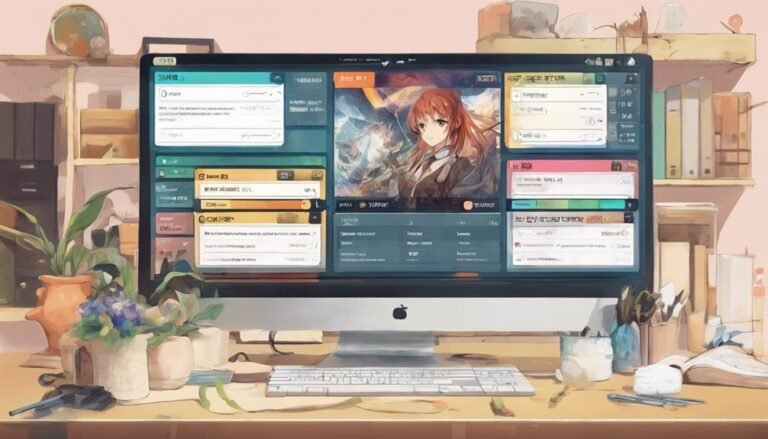How Do I Address the Needs of Learners With Disabilities in Online Courses?
To address the needs of learners with disabilities in online courses, start by understanding the varying challenges they may encounter. Implement inclusive design practices such as providing alt text for images and closed captions. Validate course materials are accessible with text-based documents and audio descriptions. Offer support services tailored to individual needs, like extended time for assessments. Use channels like real-time messaging for effective communication. Focus on equitable assessment by offering personalized modifications. These strategies create an inclusive environment for all learners. By exploring these approaches further, you can enhance your support for students with disabilities.
Key Takeaways
- Implement accessibility features like alt text and closed captions.
- Provide alternative formats for course materials.
- Offer support services tailored to different needs.
- Facilitate communication and interaction effectively.
- Ensure equitable assessment practices and accommodations.
Understanding Different Types of Disabilities
If you're new to the topic of disabilities, it's important to understand that disabilities can vary widely in type and impact. Disability awareness is vital when considering accommodations for learners in online courses. Inclusive design plays a significant role in guaranteeing that individuals with disabilities can fully participate in online learning.
Some disabilities may require specific accommodations to facilitate learning. For example, individuals with visual impairments may benefit from screen readers or alternative text for images. Those with hearing impairments might require captions or transcripts for videos. Understanding these needs is essential for creating an inclusive online learning environment.
Inclusive design goes beyond simply providing accommodations; it involves designing courses in a way that's accessible to all learners from the start. This proactive approach can help prevent barriers to learning and ensure that everyone has an equal opportunity to succeed in online courses. By considering the diverse needs of learners with disabilities, you can create a more inclusive and welcoming online learning experience for all.
Implementing Accessibility Features in Course Design
To enhance the accessibility of your online course design, consider integrating features such as alt text for images and closed captions for videos. Inclusive design plays an important role in ensuring that all learners, including those with disabilities, can fully engage with your course content.
By providing alt text for images, you make visual information accessible to individuals using assistive technology like screen readers. This simple addition can greatly improve the user experience for learners who are visually impaired.
Closed captions for videos are equally important as they benefit not only deaf or hard of hearing students but also those who may have difficulty processing auditory information.
Moreover, incorporating these accessibility features aligns with web accessibility standards, making your course compliant with regulations and guidelines. By prioritizing the implementation of these features, you create a more inclusive learning environment that caters to a diverse range of learners.
Providing Alternative Formats for Course Materials
You might need to consider providing accessible file formats like text-based documents or audio descriptions to accommodate learners with disabilities.
Consider offering multimedia accommodations such as closed captions or audio descriptions to make sure all learners can access course materials effectively.
Accessible File Formats
When considering the needs of learners with disabilities in online courses, providing alternative formats for course materials in accessible file formats is essential for ensuring inclusivity and equal access to educational content. Utilizing text to speech software and offering Braille translations can greatly benefit learners with visual impairments.
Captioned videos and ensuring screen reader compatibility are vital for students who are deaf or hard of hearing, as well as those with visual impairments. By offering materials in these accessible formats, you can make sure that all learners, regardless of their disabilities, have the opportunity to engage with the course content effectively.
Being mindful of these details demonstrates your commitment to creating an inclusive learning environment for all individuals.
Multimedia Accommodations
Consider adapting course materials into alternative formats to guarantee all learners, including those with disabilities, can access and engage with the content effectively.
Providing visual captions and audio descriptions for videos can make the content more accessible to learners who are deaf or hard of hearing.
Additionally, incorporating interactive simulations allows for a hands-on learning experience, benefiting learners with various disabilities.
For tactile learners, offering materials that can be touched and felt can enhance their understanding and retention of the course material.
Offering Support Services and Resources
By providing accessible support services and resources, learners with disabilities can thrive in online courses. Disability accommodations are vital in ensuring that all students have an equal opportunity to succeed.
Offering a variety of support resources tailored to different needs can make a significant difference in the learning experience. For example, providing alternative formats for course materials such as audio versions for visually impaired students or captioned videos for those who are deaf or hard of hearing can enhance accessibility.
Additionally, offering extended time for assignments or exams can support learners with conditions like ADHD or dyslexia. There's a clear process in place for requesting and implementing disability accommodations to streamline the support services for students.
Facilitating Communication and Interaction
To enhance the learning experience for learners with disabilities in online courses, it's crucial to establish effective channels for communication and interaction. Communication strategies play a pivotal role in ensuring that all learners can actively engage with course content.
Utilizing interactive tools such as real-time messaging or video conferencing can provide immediate support and foster a sense of community. Additionally, incorporating inclusive discussion platforms allows for diverse perspectives to be shared and valued.
Engagement techniques like breakout rooms or collaborative projects promote active participation and create a collaborative learning environment where all learners feel included and supported. Encouraging peer-to-peer interactions through group activities or forums can also enhance social connections and facilitate the exchange of ideas.
Ensuring Equitable Assessment and Accommodations
Establishing important assessment practices and providing necessary accommodations are key components in ensuring that learners with disabilities have equal opportunities to demonstrate their knowledge and skills in online courses. Individualized modifications tailored to each student's specific needs can make a significant difference in their learning experience. By implementing inclusive practices from the outset, you can create a supportive environment where all learners feel valued and capable of succeeding.
Accommodation strategies play a vital role in leveling the playing field for students with disabilities. Offering alternative formats for assessments, extended time on exams, or access to assistive technologies are just a few ways to ensure fair evaluation. It's crucial to work closely with each student to determine the accommodations that will best suit their individual requirements and enable them to showcase their abilities effectively.
Conclusion
To sum up, remember to prioritize the needs of learners with disabilities in online courses through understanding, implementing, providing, offering, facilitating, and ensuring.
By adopting these alliterative actions, you can create an inclusive and accommodating learning environment for all students.
Stay sensitive, stay supportive, and stay successful in meeting the diverse needs of every learner in your virtual classroom.







